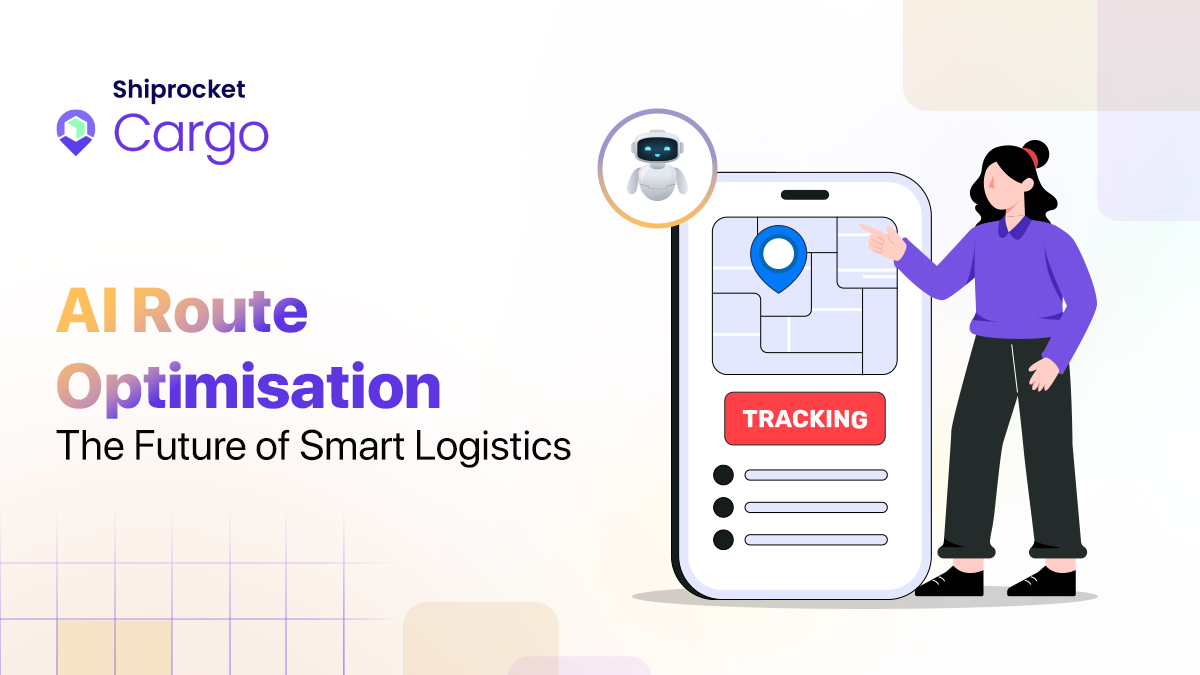Pro Tips for Smarter and More Efficient Logistics Planning
- Breaking Down Logistics Planning
- 4 Key Benefits of Smart Logistics Planning in Business
- 4 Proven Strategies for Better Logistics Planning
- PDCA: A Simple Model for Smarter Logistics Planning
- The Three-Step Approach to Logistics Planning
- 5 Must-Have Logistics Planning Software
- What Skills Help Create a Great Logistics Plan?
- How to Integrate Logistics with Other Business Functions
- Enhancing Logistics Efficiency with Shiprocket Cargo
- Conclusion
Running a successful business isn’t just about selling great products; it’s also about efficiently delivering them. The logistics industry, a key part of global trade, was valued at over 8.4 trillion euros (Rs 761.45 lakh crore) in 2021. It is projected to grow to over 13.7 trillion euros (Rs 1,246.31 lakh crore) by 2027. Poor logistics planning can lead to delays, damaged goods, and dissatisfied customers, ultimately affecting a business’s reputation and profits.
A well-structured logistics strategy helps streamline operations, reduce costs, and improve delivery timelines. To achieve this, smart planning and efficient execution are essential. Understanding key strategies for better logistics planning can make all the difference. This blog will share all the detailed information about logistics planning for a more efficient workflow.
Breaking Down Logistics Planning
Logistics planning coordinates the movement and storage of goods in a supply chain. This ensures products are delivered on time, at the right cost, and with excellent customer service. The goal is to make sure everything runs smoothly from start to finish. There are four types of logistics planning:
- Inventory Management: Ensuring the right amount of stock is available without overstocking or running out.
- Production Logistics: Ensuring the supply of materials matches production schedules for smooth operations.
- Distribution Logistics: Ensuring finished products are moved efficiently to customers, including transportation and warehousing.
- Returns Management: Managing the process for returns, replacements, or recycling to maintain customer trust.
4 Key Benefits of Smart Logistics Planning in Business
Smart logistics planning makes business operations smoother and keeps customers happy. Here’s how it helps:
- Better Inventory Management: Smart logistics uses real-time tracking to maintain stock levels, preventing waste and ensuring availability when needed.
- Faster Deliveries, Happier Customers: Smart logistics ensures timely deliveries by optimising routes and tracking shipments in real time, reducing cancellations and lost sales.
- Saving Time and Effort: Automation and data analysis streamline processes, saving time, reducing fuel costs, and improving warehouse efficiency.
- Cutting Costs: Smart logistics minimises waste by optimising routes, managing inventory, preventing delays, and saving fuel, storage, and labour costs.
4 Proven Strategies for Better Logistics Planning
Here are four proven strategies to improve logistics planning and keep your business running efficiently:
Forecast Demand with Data Analysis
Guesswork leads to wasted stock or shortages. Instead, use past sales data and market trends to predict demand accurately. This helps plan inventory, avoid overstocking or stockouts, and ensure smooth order fulfillment.
Optimise Warehouse Management
A well-organised warehouse saves time and reduces errors. Inventory management systems track stock in real-time and prevent misplacements.
Plan Efficient Delivery Routes
Fuel costs and delays add up. Route optimisation software can find the best delivery paths, avoiding traffic and reducing travel time. This ensures faster deliveries and lowers transportation expenses.
Automate with Smart Technology
Manual processes slow down operations. Innovations like Logistics management systems (LMS) can help automate order processing, inventory tracking, and shipment updates.
PDCA: A Simple Model for Smarter Logistics Planning
Running a business means constantly improving how things work. That’s where PDCA comes in. PDCA stands for Plan, Do, Check, Act. It’s a step-by-step method for solving problems, testing ideas, and improving processes over time. This cycle is used in logistics, manufacturing, and quality control to improve processes over time. Instead of fixing the same problems repeatedly, you find the real cause and create a lasting solution.
PLAN – Find the Problem and Make a Plan
Before fixing anything, you must understand the problem and decide what to do.
- What exactly is going wrong? (Late deliveries, wrong shipments, damaged goods?)
- What resources do you have? (Employees, tools, budget?)
- What changes can help solve the issue?
- How will you know if the plan is working?
At this stage, set clear goals and make sure your team understands what needs to be done.
DO – Test Your Plan
Now, take action! But instead of making big changes at once, test on a small scale first.
- Train employees on the new plan.
- Make sure everyone knows their role.
- Track how things are going.
It can reduce mistakes before applying changes everywhere.
CHECK – Review the Results
This step is about analysing the data. Did the plan work? If deliveries are still late, find out why.
- Compare before and after results.
- Look for unexpected problems caused by the changes.
- Identify what worked and what didn’t.
If the plan isn’t successful, go back to step one and try a new approach.
ACT – Apply or Improve the Plan
If the plan works, make it permanent. Train employees, update processes, and monitor the results. If things still need improvement, adjust the plan and try again. The goal is to keep improving until everything runs smoothly.
The Three-Step Approach to Logistics Planning
Let’s break down the three steps to effective logistics planning and how you can improve each step.
- Step 1: Understand How Things Work Right Now
Before making changes, assess your current logistics. Identify what’s working and what needs improvement.
- Check if products are tracked properly to avoid delays or stockouts.
- Review routes and methods to improve delivery speed and reduce costs.
- Ensure warehouses are well-positioned for faster product delivery.
- Step 2: Set Clear Goals for Improvement
After understanding the current situation, set clear, measurable goals:
- Cutting delivery time by a certain percentage.
- Reduce transportation or storage costs by using more efficient methods.
- Aim for fewer shipping mistakes and faster resolutions.
- Step 3: Analyse and Improve Your Supply Chain Network
With goals in mind, analyse your supply chain:
- Ensure warehouses are strategically placed for quick, cost-effective service.
- Optimise routes to reduce time and fuel costs.
- Ensure suppliers are consistently on time to avoid disruptions.
Incorporating technology is also a big help. Logistics software or automation tools can track inventory, monitor shipments, and predict delays, helping you stay ahead of potential issues. Modern service providers also offer tools like automated inventory and transportation management, improving efficiency and reducing costs.
5 Must-Have Logistics Planning Software
Logistics software is essential for businesses aiming to streamline their supply chain operations. The logistic software market is projected to grow from USD 10.9 billion in 2024 to USD 22.3 billion by 2032, with an 8.00% CAGR. Here are five well-known logistics software solutions:
- ClickUp
ClickUp is a cloud-based tool that simplifies project management, inventory control, and logistics for businesses of all sizes. With real-time collaboration and over 200 tool integrations, including Slack and Figma, it offers customisable views and templates for warehouse KPIs and agile project management.
- Oracle Transportation Management (OTM)
Oracle’s OTM is designed for global supply chain management. It features 3D load configuration, rate management, network routing, and predictive analysis, helping businesses optimise capacity planning and automate administrative tasks.
- SAP Transportation Management
SAP’s software focuses on optimising digital supply chains. It supports freight planning, execution, and settlement with automation features like capacity planning, predictive forecasting, and simulation for global and domestic supply chains.
- Acumatica
Acumatica is a cloud ERP system with logistics management apps, such as inventory control, order tracking, and warehouse management. Its all-inclusive licensing model lets businesses monitor operations from any device at a single price.
- NetSuite Cloud ERP
NetSuite simplifies logistics by handling finances, inventory, and order processing. It automates workflows, manages inventories across multiple locations, and ensures global supply chain compliance, including region-specific currencies and tax rules.
What Skills Help Create a Great Logistics Plan?
Here are the most essential skills for creating a great logistics plan:
1. Organisation: Organisation helps you track everything in your logistics plan, including where items are, when they need to be delivered, and how to get them there.
2. Problem-solving: Things won’t always go as planned. Problem-solving skills allow you to find solutions when issues come up quickly.
3. Communication: Clear communication with your team and customers ensures everyone knows what’s going on and things run smoothly.
4. Time Management: Good time management ensures you meet deadlines and keep everything on schedule.
5. Flexibility: Things change, and being flexible helps you adapt quickly to new situations, like delays or customer changes.
How to Integrate Logistics with Other Business Functions
To integrate logistics with other business functions, a company should focus on aligning processes across departments. Here are some key strategies for the most efficient integration:
- Technology Integration
Implement an Enterprise Resource Planning (ERP) system to centralise department data. This gives real-time visibility into inventory levels, order statuses, and shipment tracking, making coordination between logistics and other departments smoother.
- Data-Driven Decision Making
Data analytics can be used to identify bottlenecks in the supply chain, optimise delivery routes, and forecast demand. These insights help make sales, marketing, and operations decisions, improving overall efficiency.
- Cross-Functional Collaboration
Establish clear communication channels between logistics and departments like sales, marketing, customer service, and finance. Regular meetings help align strategies, address potential issues early, and ensure smooth operations.
- Inventory Management
Leverage advanced inventory management techniques to maintain optimal stock levels. This prevents stockouts, minimises carrying costs, and directly impacts sales and customer satisfaction.
Enhancing Logistics Efficiency with Shiprocket Cargo
So, you’re looking for an easier way to ship heavy orders. Shiprocket Cargo might just be what you need! It covers over 24,000 pin codes across India, so whether your customers are in big cities or small towns, you’ve got them covered. The platform works with multiple delivery partners, giving you plenty of options. Plus, it uses smart AI to pick the best courier for each shipment, so you don’t have to worry about it.
You can track every order in real time, which makes it easy to stay updated. The best part? Shiprocket Cargo saves you money while ensuring deliveries are on time—even at odd hours. With 24/7 support, you’ll always have help when you need it. Let Shiprocket Cargo handle the logistics so you can focus on growing your business!
Conclusion
Effective logistics planning is key to keeping your business running smoothly. Focusing on important areas like having the right products in stock, ensuring timely deliveries, and reducing unnecessary costs makes everything more efficient. Using the right tools and software to manage logistics is crucial, as it makes tracking easier and helps you stay organised.
When logistics are well-planned, deliveries are faster, waste is minimised, and customers are more satisfied. Ultimately, good logistics planning not only improves your business’s operations but also helps it grow and succeed in the long run.



